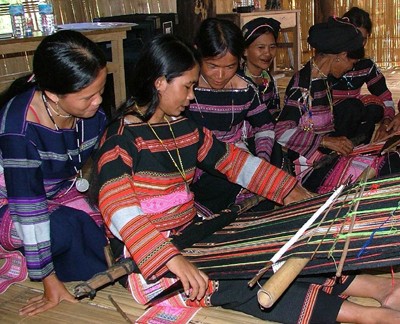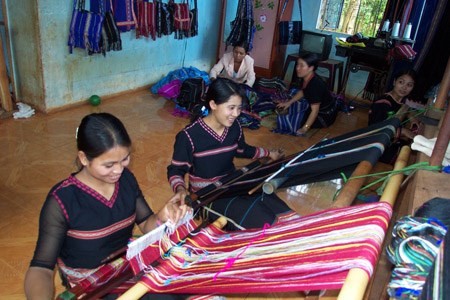(VOVworld) – The Bana have an aged-old tradition of brocade weaving. Their handmade products have elegant patterns and colors which reflect their rich culture and spiritual life.
 |
Bana girls in Ha Ri village, Vinh Thanh commune, Binh Dinh province
|
Bana girls learn weaving from their mothers and grandmothers from the age of 12 or 13. They weave brocade fabric to make clothes, blankets, and carpets, and their own wedding gowns to show off their skills. The simple loom is made of wood. Dao Thu Nguyet, a docent at the Dac Lac Ethnic Museum, talks about Bana weaving. “In the past, we grew cotton for material. We ginned cotton, spun it into thread, and dried it. Now we use industrial threads sold at the market, but still uphold our traditional weaving techniques, designs, patterns, and colors.”
The main colors are black, red, and yellow. Red represents fertile land and forests. Red is the color of love and aspiration. Yellow is the sunlight. The brocade of the Bana has bright colors reflecting their aspirations, dreams, and artistic mind. They often create symmetric patterns to symbolize the universe, yin and yang, the earth and sky, and nature. Bui Van Nam works for the Dac Lac Provincial Committee for Ethnic Affairs. “The hand-made fabric is beautiful and durable. They may spend more than a year weaving a cloth. The fabric is soft and comfortable.”
 |
The Bana have always tried to pass their traditional craft to the younger generation. But in recent years, the craft is at risk of being lost because a few young people practice the craft and the skilled weavers are getting older. The provincial authority has taken steps to promote the Bana weaving craft. Luong Thanh Son, Director of the Dac Lac Ethnic Museum, said: “The government has policies to preserve the culture of ethnic groups. Activities have been organized, including weaving classes. It’s important to communicate with ethnic people about their precious culture and ways to preserve their weaving craft.”
The cultural sector has organized art exchanges and costume contests for ethnic groups to promote their unique cultures.